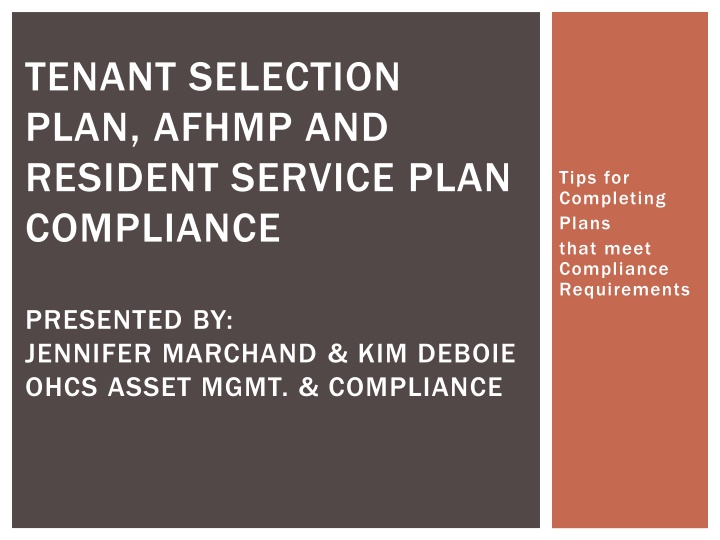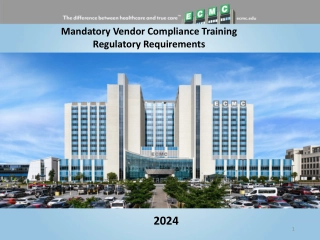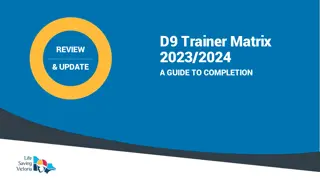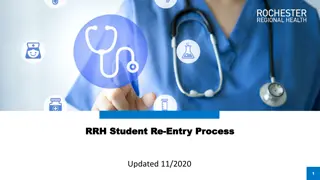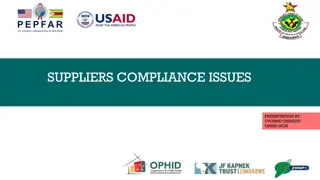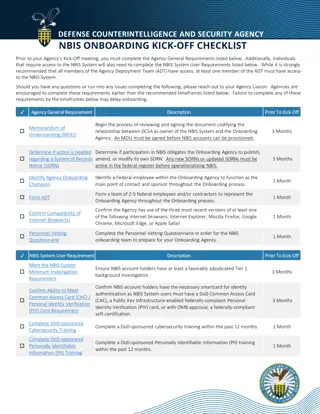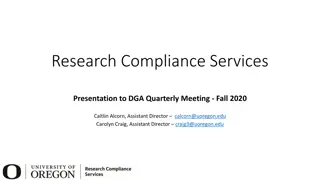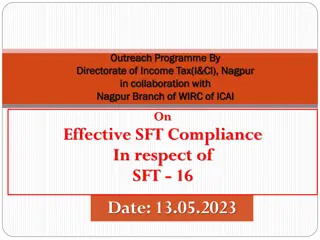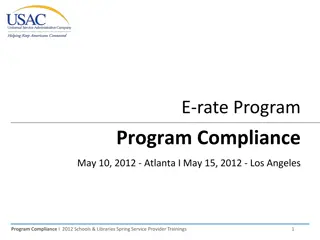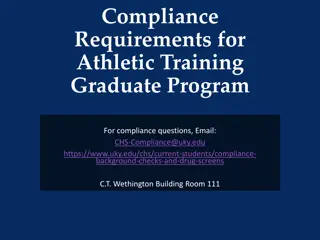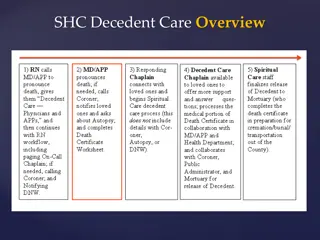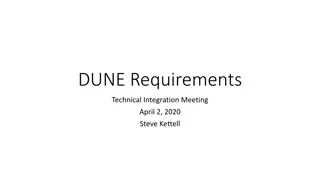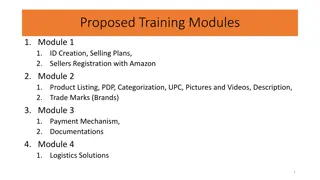Completing Plans for Compliance Requirements
"Tips for ensuring compliance with Tenant Selection Plan, AFHMP, and Resident Service Plan. Learn the importance of TSPs, why they are essential, and how to create an efficient TSP that meets all criteria."
Download Presentation

Please find below an Image/Link to download the presentation.
The content on the website is provided AS IS for your information and personal use only. It may not be sold, licensed, or shared on other websites without obtaining consent from the author.If you encounter any issues during the download, it is possible that the publisher has removed the file from their server.
You are allowed to download the files provided on this website for personal or commercial use, subject to the condition that they are used lawfully. All files are the property of their respective owners.
The content on the website is provided AS IS for your information and personal use only. It may not be sold, licensed, or shared on other websites without obtaining consent from the author.
E N D
Presentation Transcript
TENANT SELECTION PLAN, AFHMP AND RESIDENT SERVICE PLAN COMPLIANCE Tips for Completing Plans that meet Compliance Requirements PRESENTED BY: JENNIFER MARCHAND & KIM DEBOIE OHCS ASSET MGMT. & COMPLIANCE
AGENDA Introductions The Who, What, Why and How of: Tenant Selection Plans AFHMP s Resident Service Plans
TENANT SELECTION PLANS WHAT/WHO What is a Tenant Selection Plan (TSP) and who is it for? A written tenant selection plan should be made available to all applicants before before they apply for housing. The plan describes how you choose applicants for tenancy and what criteria the applicant will need to meet in order to qualify.
TENANT SELECTION PLAN WHY Why is a TSP Important? Applicants will see that you take tenant selection seriously and don t choose tenants arbitrarily. They will know exactly what your criteria is for tenancy. This will help applicants know if they won t fit your criteria which can result in an applicant pool that is more likely to meet requirements.
TENANT SELECTION PLAN WHY Why Continued: If applicants first learn about an aspect of your screening criteria from a rejection letter, they re far more likely to get upset and question the legitimacy of their rejection. They make take it very personal and a written document explaining procedures will help them understand the reason they were rejected. Letting applicants know your qualifications for tenancy up front helps streamline the screening process and lower your risk for liability as well as for lowering the chances of a misunderstanding or even a fair housing complaint/lawsuit.
TENANT SELECTION PLAN HOW How do you create an efficient TSP? What should you include? Remember that: Tenant Selection Plans should be clean and concise and easy to understand. They do not need to be long or include legal/formal language. Plans should be specific to each property. Plans should include all information needed to help the applicant determine if they will qualify for tenancy at the property.
TENANT SELECTION HOW How to create continued: Before you create a written tenant selection plan, make a list of all the criteria that you consider and use to screen applicants. Include all of the minimum company policy requirements such as: Income-to-rent ratio (Remember ORS 456.722) Minimum credit score and history Employment history Rental history Criminal background history (Refer to HUD memo Guidance on Application of Fair Housing Act Standards to the Use of Criminal Records by Providers of Housing and Real Estate- Related Transactions )
TENANT SELECTION HOW Also consider property specific requirements that factor into the Management selection and screening process: Preferences and waitlist management Occupancy requirements Income limit requirements Specific program funding requirements (such as Student rule) Identify verification and certification requirements Describe how lower set-aside units will be swapped Policy for unit transfers Procedure for placing applicants on several wait lists Procedure for removing applicants from wait list Procedure for weeding of wait list Procedure for rejections Violence Against Women Act Protections (VAWA)
TENANT SELECTION HOW Make sure that you indicate how vacant units will be filled *Such as chronological order of application And And When considering the marketing requirements of accessible units you must offer the accessible unit to: 1. Existing residents who need the features of the unit 2. Waiting list applicants who need the features 3. Advertise features 4. Next on waiting list (may not need the features)
TENANT SELECTION HOW In addition to outlining what you require of applicants, your tenant selection plan is a good place to communicate the fact that you follow all applicable fair housing laws and that you don t engage in illegal discrimination. Federally Protected Classes: Federally Protected Classes: Race color national origin religion gender familial status disability State Protected Classes Include: State Protected Classes Include: marital status source of income sexual orientation including gender identity domestic violence victims http://www.fhco.org/information-for-housing-providers
TENANT SELECTION DOS & DON'TS Do keep the Tenant Selection Plan current Do update as needed Do not create a plan once and forget about it Your tenant selection plan can become a liability trap if you let it get outdated. If you make a change to your policies (for example, you raise the minimum credit score or you begin to seek prior landlord references), promptly update your plan to reflect all revisions. This way, if a rejected applicant claims you acted unfairly, you won t be in the difficult position of having to prove you followed your own policies despite what it may say in your tenant selection plan.
TENANT SELECTION DOS & DON'TS Do have one plan for each specific property Do not create a plan that is based on company policy only Remember that Tenant Selection Plans are created for the applicants and tenants of each specific property. The plans are not intended to be company policy and procedure documents. Do use clear and concise (easily understandable language) Do include all information but keep as brief as possible Do not create a plan that is overly large and includes all company policies and procedures
TENANT SELECTION DOS & DON'TS Do include property specific funding requirements Do not include requirements for funding that does not exist at the property Do include enough information so that the applicant/tenant will know if they qualify For example: When listing the Student Rule requirements list the specific exemptions.
TENANT SELECTION DOS & DON'TS Do include specific information on the rejection of ineligible applicants including: 1. Reasons why an applicant may fail the Screening Criteria 2. How an applicant will be notified that they are rejected 3. Appeal Process What you need to know: Applicants who are denied must receive proper notice of denial explaining reason for denial in writing Appeal process must be communicated Documentation must be kept on file for review The application along with the denial notice must be kept and made available to OHCS, HUD, or Fair Housing when requested
THE AFHMP WHAT/WHY What is an AFHM Plan (AFHMP)? The Affirmative Fair Housing Marketing Plan is a marketing strategy designed to attract renters of all majority and minority groups regardless of race, color, gender, religion, national origin, disability or familial status and additionally in Oregon: marital status, source of income, sexual orientation, gender identity, domestic violence victims and voucher holders (rental assistance) to rental units in the property. Why do we have an AFHM Plan? The main purpose of an AFHM Plan is to help Owners, Developers, and Management Agents effectively market the availability of housing opportunities to individuals of both minority and non- minority groups that are least likely to apply least likely to apply for occupancy.
THE AFHMP WHAT What does least likely to apply mean? Least Likely to Apply means there is an identifiable presence of a specific demographic group in the housing market area, but members of that group are not likely to apply for the housing without targeted outreach, including marketing materials in other languages for limited English proficient individuals, and alternative formats for persons with disabilities. Reasons for not applying may include, but are not limited to, insufficient information about housing opportunities, language barriers, or transportation impediments.
THE AFHMP WHO Who must complete AFHMP s? Most all federal or state funded, insured or assisted, housing programs with five or more units in Oregon have an obligation to create, implement and maintain an Affirmatively Fair Housing Marketing Plan. Federal Housing Agency (FHA) subsidized and unsubsidized multifamily housing programs HUD Section 8, 202, etc. USDA Rural Development All OHCS Financed Developments with 5 or more units LIHTC, HOME, and Bond Funded Properties
AFHMP HOW How do I complete an AFHMP? Owners/Developers and Management Agents of multi-family housing properties must conduct appropriate research regarding the property and the market area of the property to determine the appropriate affirmative marketing methods that will be utilized best to meet the requirements. Then, documenting the research and methods for this required work must be done by completing the AFHMP Form HUD-935.2a as specified in 24 CFR 200.625, and in accordance with the requirements in 24 CFR 200.620.
AFHMP HOW How do I create an effective plan? The creation of an Affirmative Fair Housing Marketing Plan can be broken down into the following four (4) areas: Step 1 Step 1 Targeting. Identify the segments of the eligible population which are least likely to apply for housing without special outreach efforts. First establish the Housing Market Area. This is the area from which an owner/agent can reasonably expect to draw a considerable number of tenants for the property City/Metro Area Second determine the Expanded Housing Market Area. This is a larger geographic area that may provide additional demographic diversity in terms of race, color, national origin, religion, sex, familial status, or disability County, Metropolitan Statistical Area.
AFHMP HOW Step 2 Step 2 Outreach Outreach. Develop an outreach program that includes special measures designed to attract those groups identified as least likely to apply and other efforts designed to attract persons from the total eligible population. Be creative and devise ways to reach the population identified in step 1: Community Contacts the provider must list at least one community organization that serves each group determined to be least likely to apply and who has agreed who has agreed to help the provider in their marketing efforts. Media the provider should specify the particular means of advertising used to reach a target group with reasoning behind it. behind it. If the immediate housing market is not demographically diverse enough to draw least likely, then an expanded housing market should be used. reasoning
AFHMP HOW Step 2 Step 2 Outreach (continued)... Outreach (continued)... All Marketing Material Applications, Notices, and Publications must include the Fair Housing & Equal Opportunity Logo / Statement. The accessibility logo must also be present if the property offers accessibility features. Where necessary, marketing materials should be published in multiple languages to better reach potential applicants in the area with language limitations
AFHMP HOW Step 3 Step 3 Assessment Indicators. Assessment Indicators. Develop a plan for the information that you are going to track that will allow you to measure the plan s effectiveness. Examples of methods that can be used include: Noting if the program effectively attracted renters who are from the majority and minority groups including persons with disabilities and families with children as represented in the total population of the housing market area. Tracking how many referrals you have received from the groups identified for outreach in your area; Logging how many walk-ins or phone inquiries are received from people who indicate they are responding to your marketing.
AFHMP HOW Step 4 Step 4 Training. Training. Demonstrate the capacity to provide training and information on Fair Housing Laws and objectives to staff. Training is an ongoing commitment to fair housing and there will always be more to learn. Owners/Agents must provide their staff fair housing training at least annually. Owners/Agents must ensure that all staff understands the specific AHFMP specific AHFMP for their property.
AFHMP WHEN When must an AFHMP be created? At Development/New Property When new funding is being added; OR When new management begins at property; OR Whenever it is determined that current outreach to targeted populations has not proven effective; OR When adopting a residency preference for admission of persons who reside in a specified geographic area; OR At the required review period (every 5 years)
AFHMP DOS AND DON'TS Do complete the plan in full Do sign and date plan Do train employees on the specific plan Do not consider typical Fair Housing training as meeting your training requirement for the AFHMP AFHM TRAINING AFHM TRAINING All Owners/Agents must comply with certain requirements for the duration of each applicable affordability period for each property, including but not limited to AFHMP Training While one person may be the responsible party for marketing efforts, all staff must be trained and be familiar with the property s specific AFHMP requirements. This training component will play a major role in the assessment of whether you are making good faith efforts to educate the staff and implement the plan.
AFHMP DOS AND DON'TS Do keep records of advertising Do post plans on site Do not keep the only copy of plan at corporate office Do check in with plan contacts periodically Recordkeeping: Owners/Agents must maintain records of all marketing efforts (copies of newspaper ads, memos of phone calls, copies of letters, brochures, flyers, web postings, etc.) Copies of Analysis documents and reports that demonstrate compliance with requirements to review / update plan The property must also post and have available the approved HUD Form 935.2a and documentation supporting that it has been reviewed by OHCS. During Annual Reviews, the O/A must be able to produce documentation demonstrating their compliance with AFHM requirements and their approved plan. These records must be available for inspection upon request.
AFHMP RESOURCES AFHM Guidelines are available on OHCS website: AFHMP Compliance Guide (4/2018) summarizes the AFHM plan and affirmative marketing procedures as required by federal and state regulations and provides step-by-step instructions on how to effectively develop a property marketing plan to meet requirements and achieve the greatest possible positive impact. https://www.oregon.gov/ohcs/APMD/PCS/pdf/OHCS-AFHMP- Guide.pdf US Census American Fact Finder Guide (4/2018) offers assistance on locating the correct census data for the property https://www.oregon.gov/ohcs/APMD/PCS/pdf/American- FactFinder-How-To.pdf AFHM Form HUD-935.2A, is available on HUD s website at: www.hud.gov
RESIDENT SERVICE PLAN WHAT/WHY What is a Resident Service Plan (RSP)? A written plan that describes specific services that will be available to all tenants who occupy the housing. Why is a RSP needed? Beside that fact that it may have been mandated by the funding sources allocated to the property, resident services are an integral piece of building a supportive environment for individuals and families who are experiencing poverty and are at a greater risk for poor outcomes. The plan itself documents the fact that the services offered have been well thought out and designed to meet the needs of the resident population.
RESIDENT SERVICE WHY Why are Resident Services important to OHCS? While affordable housing is extremely important in creating stability for low income Oregonians, conquering other existing risk factors has a cumulative effect on enhancing a family s life prospects. Successful Resident Service programs have been proven to contribute indirectly to property management by reducing turnover, decreasing maintenance costs, and freeing property managers from the burden of handling personal and interpersonal issues.
RESIDENT SERVICE PLAN HOW How can you create an effective RSP? Think about the main goal. When receiving OHCS funding the anticipated outcomes and overall goals of the Resident Services Description and subsequent plan are as follows: Through coordination, collaboration, and community linkages, residents will be provided the opportunity to access appropriate services which promote self-sufficiency, maintain independent living, and support them in making positive life choices; and To maintain the fiscal and physical viability of the development by incorporating into the ongoing management the appropriate services to address resident issues as they arise
RESIDENT SERVICE PLAN HOW At a minimum the Resident Services Plan for an OHCS funded property must include these general guidelines: When created for: General General low low- -income population income population support and services may include improving residents ability to maintain their lease obligations, enhance quality of life through programs for employment, education, income/asset building, child and youth development, community building and improving access to services. Elderly Elderly support and services support and services should include improving residents ability to uphold their lease throughout the aging process through better access to health and other services, enhanced quality of life through community building, socialization, and other programs. Support Support and services for special needs population and services for special needs population should focus on the strengths and needs of the target population to provide for not only the daily support but to be part of the larger community.
RESIDENT SERVICE PLAN HOW To receive funding consideration OHCS requires that each funding application submitted include a plan that outlines the following: Questions in funding application: 1. Describe the type of housing population(s) proposed for this project and their anticipated needs. 2. Describe your plan to meet the needs of the tenants this project will serve. 3. Specify any existing or proposed contractual agreements that will be in place with local service providers for this project. 4. Describe how resident services will be coordinated with ongoing property management of the project. 5. Describe how you developed your estimated services costs and how it aligns with your development budget.
RESIDENT SERVICE PLAN HOW The funding application also requests the following information: Type of Offsite Resident Services (i.e. Financial fitness, education, food, special needs) Identify the entity or person responsible to provide or coordinate this service Anticipated Outcome or Goal Number of tenants anticipated to participate in this service
RESIDENT SERVICE DOS AND DON'TS Do update plan as needed Do track services and participation Do communicate with residents about their needs (on a regular basis) Do communicate with Owner regarding plan that was proposed at development Do not discontinue or change services without prior OHCS approval Do not sign or enter into MOU s that may violate funding regulations Do not require that tenants participate in services
WAITLIST TIPS A waiting list must be established and maintained so that OHCS, HUD and FHCO can follow the progression of applicant placement. What you need to know: Format should be written Applicants should receive notification in writing of eligible/ineligible status on wait list Notification should state the approximate time of unit availability Format must be in a form that can be audited Applicant must be offered the chance to accept or reject before offering to the next applicant Indicate your procedure for weeding/purging list and moving to next applicant *Purging the list on a regular basis is very IMPORTANT *Closing and Reopening the list requires permission and special action that must be followed
THANK YOU! On behalf of the whole OHCS Asset Management and Compliance team we thank you for attending today! Please let us know how we can help you maintain compliance. Jennifer Marchand Multifamily Compliance Technical Advisor 503-986-2031 Voice Jennifer.C.Marchand@Oregon.gov (email) Kimber DeBoie Portfolio Management Officer 503-986-2018 Voice Kim.DeBoie@Oregon.gov (email) Oregon Housing and Community Services 725 Summer Street NE, Suite B Salem, Or. 97301 http://www.ohcs.oregon.gov
